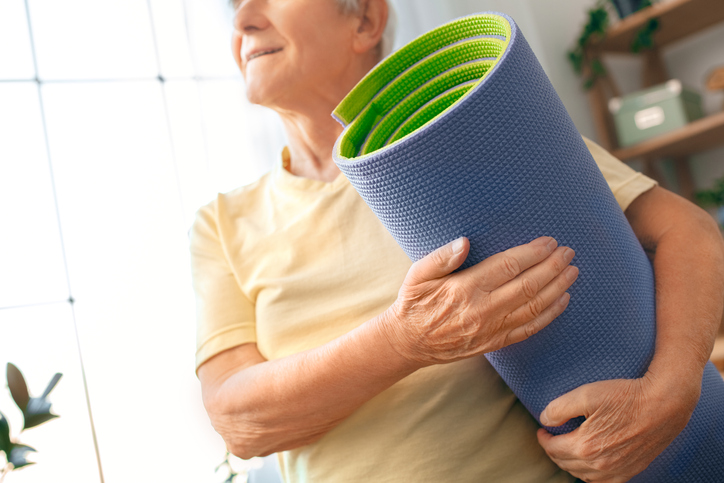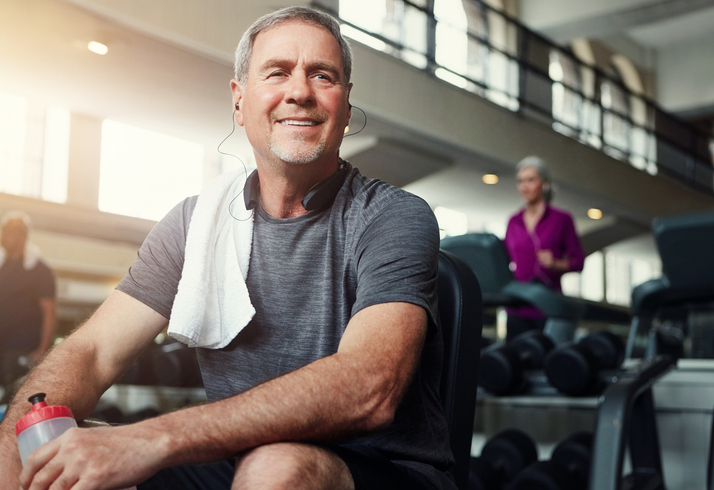How to Boost Benefits and Reduce Risks for Older Adults
By Carol Krucoff, C-IAYT, E-RYT

In recent years, there’s been a growing interest in making yoga accessible to everybody—thanks, in large part, to the work of Jivana Heyman, director of the Accessible Yoga Association, whose mission statement proclaims that “all people—regardless of ability or background—deserve equal access to yoga.” 1
This is a welcome development in the yoga community. For too long, media images have portrayed yoga practitioners as slim, bendy youngsters—usually white females. So it’s not surprising that prospective yoga students often express concern that “I’m not flexible enough to do yoga.” In more than two decades of teaching yoga in medical settings, I’ve heard this wistful phrase from countless people who have mistakenly assumed that yoga isn’t for them. Yet despite the common misconception that yoga enthusiasts are all young and flexible, the reality is that more than a third of Americans who practice yoga are age 50 and older. 2
Seniors often come to the practice after hearing about yoga’s numerous health benefits—including improving blood pressure, heart rate, and insulin resistance 3, relieving anxiety and depression 4, easing back pain 5, and alleviating sleep problems. 6 there is also a growing trend for health care providers to “prescribe” yoga as a complementary therapy to help prevent and treat a variety of medical conditions. 7
Seniors’ strong interest in yoga during a time when older adults are the fastest-growing sector of the population. 8 presents a great opportunity and a serious challenge for yoga instructors. Because like any therapeutic intervention that offers health benefits, yoga practice also carries potential risks, and older adults are more likely than younger people to get hurt doing yoga. 9 Some commonly-taught yoga poses may be risky for older adults. 10
These important considerations are generally not included in basic yoga teacher trainings. This is why, in 2007, we launched our first Integrative Yoga for Seniors Professional Training at Duke Integrative Medicine. As yoga teachers working in medical settings, Kimberly Carson and I sought to combine the best of current, evidence-based medicine with the ancient wisdom, experience, and tradition of Yogic teachings. We invited Duke Medical Center Faculty to present talks on age-related health issues such as heart disease, arthritis, and osteoporosis. We used the science-based movement considerations they recommended to inform our approach to teaching yoga to seniors.
Today our program has evolved into an annual 50-hour master training—which will be offered virtually this year—and is designed to give yoga instructors the skills and confidence to safely and effectively teach older adults. Completing at least 200-hour yoga teacher training or equivalent is a prerequisite for enrollment. Graduates can receive continuing education credits from the Yoga Alliance, the International Association of Yoga Therapists, and the National Board for Health & Wellness Coaching. The course text is our book, Relax into Yoga for Seniors: A Six-Week Program for Strength, Balance, Flexibility and Pain Relief.
Safety—the Yogic concept of “ahimsa” (non-harming)—is at the heart of our approach. We encourage older adults to challenge themselves but avoid strain, which can be complicated for yoga teachers trying to create classes for a population with many abilities. While some seniors are extremely fit and able to run marathons, others are quite debilitated and unable to get out of bed. By age alone, even the fittest and vital older adults need to keep safety in mind—especially if they are new to the yoga practice—as seniors are more likely to have a medical condition that may increase their risk of injury.
Approximately 85 percent of older adults have at least one chronic health condition, and 60 percent have at least two. 11 In addition to known, diagnosed diseases, seniors are at a higher risk than younger people for “silent” diseases that may be aggravated without warning, including hypertension, heart disease, and osteoporosis. The first symptom of osteoporosis may be a broken bone, and the first symptom of heart disease may be a heart attack or sudden death.
The complexity of teaching yoga to older adults is that 90 percent of seniors take at least one prescription drug, and nearly 40 percent take five or more. 12. Several medications commonly taken by seniors–including antihypertensives, antianxiety drugs, and antidepressants–are associated with an increased risk of falls. 14 The use of five or more drugs is associated with a 21 percent increase in the risk of falls. 14
A further complicating factor is that many older adults are out of shape. More than one in four American adults over age 50 do not engage in regular physical activity–a percentage that jumps to more than one in three for people 75 and older. 15 These data also highlight the potential for harm if yoga instructors do not create a safe environment and class structure geared appropriately to older adults. For some older adults who are new to yoga, even seemingly simple expectations, such as changing positions from standing to lying down, may be emotionally fraught or even humiliating if they cannot lie down on the floor and get up again easily.
For over a decade, we’ve been dedicated to making yoga practices available and appropriate for older adults through our Yoga for Seniors network of trained instructors. We have published specifics of our evidence-informed approach in the medical journal OBM Geriatrics. 16 Making yoga accessible to seniors involves considering older adults’ most common health challenges – heart disease, arthritis, osteoporosis, and hypertension. And it also acknowledges the reality that many older adults are deconditioned. It’s important to recognize that individual seniors may be exceptional—if a 70-year-old has practiced yoga headstands every day since childhood–that practice may be fine for that person. However, for most older adults, especially those new to the practice, we recommend:
We encourage students to hinge at the hips (not the waist), bend their knees, and keep their spine in a neutral alignment when folding forward.
Since most older adults cannot sit comfortably on the floor with a neutral spine, we teach seated poses in a chair—and let the chair back serve as a support when we do standing poses.
Inverted postures may be risky for people with cardiovascular concerns.
Breath-holding can affect blood pressure and is inadvisable for people with heart disease and/or hypertension. More than 63 percent of Americans over age 60 have high blood pressure. 17 While the gentle suspension of the breath after exhalation may be fine, holding the breath after inhalation should be avoided.
Deep twists are contraindicated for people with low bone density. 18
Extreme movements may put people at risk of injury, and extreme breathing practices such as Kapalabhati and Bastrika may be problematic for people with heart disease and/or hypertension.
Over more than two decades of teaching yoga to people with health challenges and age-related issues, we have gained a deep respect for individual differences and the importance of honoring each person’s unique journey. While our priority is creating a safe and welcoming environment for each student, it’s equally essential to ensure that this imperative of safety does not create a sense of fear or limitation. Rather, our focus is on inviting the empowering recognition of yoga’s highest teachings that our true nature is already whole.
Some Commonly-Taught Yoga Poses May Present Risks for Older Adults
Chair Stand Can Boost Strength and Help Maintain Independence
As the new year begins, many of us set fitness goals that require finding the right gym. Choosing the right facility can significantly impact your motivation and progress. Here are five essential factors to consider before signing up.

Aromatherapy, the practice of using essential oils extracted from plants for therapeutic purposes, has been a cornerstone of holistic health for centuries. Rooted in ancient traditions, it has grown in popularity in modern times due to its ability to promote relaxation, alleviate stress, and improve overall well-being. This article explores ...
READ MORERadical acceptance is the practice of fully accepting reality without judgment or resistance. It is not about approving harmful situations or giving up but rather letting go of the internal struggle against reality. This transformative approach can reduce emotional suffering and foster inner peace. Explore the concept of radical acceptance ...
READ MORE